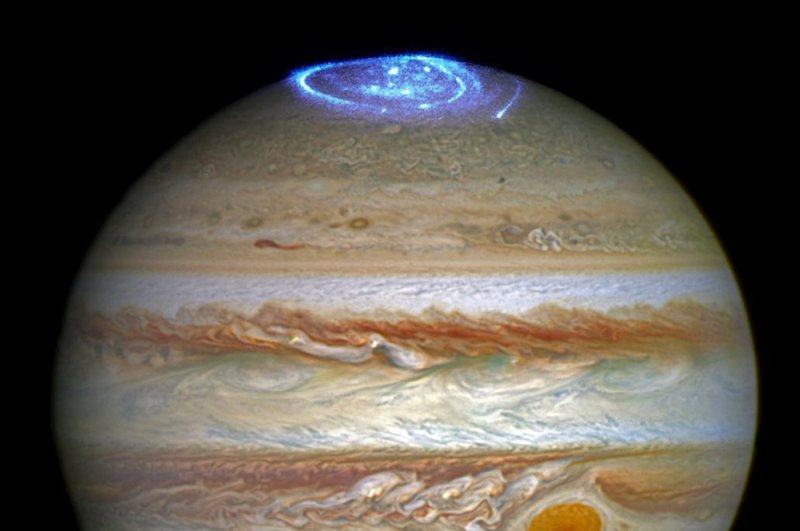Jupiter's polar auroras are the brightest in the solar system. Photo by NASA/ESA/J. Nichols/University of Leicester
July 11 (UPI) -- New analysis of Juno mission data suggests Jupiter's auroras are powered by alternating current, not direct current.
Jupiter, a the largest planet in the solar system, boasts an aurora with a radiant power of 100 terawatts, or 100 billion kilowatts. It's the brightest aurora in the solar system.
Like Earth's auroras, Jupiter's light shows are centered around its poles. The auroras are fueled by a system of electric currents running through the gas giant's magnetosphere.
"'Jupiter's electric current systems are driven by the enormous centrifugal forces in Jupiter's rapidly rotating magnetosphere," Joachim Saur, researcher at the University of Cologne, said in a news release. "Because of Jupiter's fast rotation -- a day on Jupiter lasts only ten hours -- the centrifugal forces move the ionized gas in Jupiter's magnetic field, which generate the electric currents."
When gas particles in Jupiter's upper atmosphere are excited by charged particles produced by the interactions between solar winds and the planet's magnetosphere, a brilliant, swirling glow is produced.
For the last three years, NASA's Juno spacecraft has been circling Jupiter. Its orbit passes over both poles. Recently, Juno used its instruments to measure the direct electric currents running through Jupiter's magnetosphere. Analysis of the Juno data showed Birkeland currents, direct currents running along the gas giant's magnetic field lines, totaled 50 million amperes.
According to the new study, published this week in the journal Nature Astronomy, direct currents measured by Juno can't entirely account for the power of Jupiter's auroras. Therefore, scientists concluded alternating, turbulent Alfvenic currents, are helping fuel the gas giant's polar light shows.
"These observations, combined with other Juno spacecraft measurements, show that alternating currents play a much greater role in generating Jupiter's aurora than the direct current system," Saur said.
The latest research has revealed new ways in which Jupiter's auroras differ from those on Earth.















